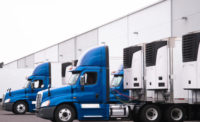
With ever-increasing pressure on supply chains to improve cost structure and better optimize processes, a major focus has been on improving efficiencies. This includes the use of inland ports.
“Among the advantages inland ports offer are the potential for lower priced real estate, wage rates, energy and operating costs,” says Brian Beattie, president of Western U.S. Operation for Lineage Logistics. “They can also be considered a greener alternative due to a quicker movement of containers away from congested seaports and more efficient storage capabilities.”
In addition, Beattie notes inland ports deliver benefits for both import and export goods.
“Many seaports and port warehousing locations have been at capacity for a number of years,” he says. “Inland port locations are providing an alternative to handle and store goods that were imported or are getting ready for export.”
A variety of systems
While primarily used for break bulk and nonperishables container freight, demand for inland ports has been increasing.
Some inland ports like the Port of Virginia’s Richmond Marine Terminal (RMT) in Richmond, Va., are physical places involved in the transloading of cargo from one transport mode to another. Others operate as statewide systems.
RMT operates on 80 acres within a secure terminal and has a 1,570-foot-long wharf available for berthing and handling containers, including those that are temperature controlled. What makes this port unique is its barge service to and from the Port of Virginia in Norfolk, which offers two portable 40-plug central power units used in transporting refrigerated goods.
The expanded refrigerated cargo capability on barges is part of the port’s larger strategic growth plan to make the port a destination for cold cargo.
Similarly, Dallas, Texas, offers inland port advantages. The International Inland Port of Dallas (IIPOD) operates as an intermodal and logistics district that encompasses 7,500 acres over five municipalities.
Other locations in the United States have also exploded as inland logistics centers. One is Logistics Park Kansas City (LPKC), a 3,000-acre, master-planned distribution and warehouse development in Edgerton, Kansas.
The Utah Inland Port Authority (UIPA) operates as a statewide system. It provides “smart, sustainable and equitable logistics solutions that use a statewide, multimodal approach to increase utilization and expand commerce access throughout the state.” UIPA leverages expertise, facilities and infrastructure, and capital investment to improve logistics within the statewide system.
Of note is the agreement UIPA signed with the Port of Long Beach in California to improve cargo flows between Southern California and Utah, Colorado, Nevada, and Idaho.
The Union Pacific (UP) Railroad is playing a part in the initiative. UP’s direct rail service between the Port of Long Beach and Salt Lake City will allow cargo to be rapidly evacuated from terminals in Long Beach for further distribution throughout the region. Much of that cargo currently moves by truck and only 10% by rail.
Inland port advantages
One of the biggest advantages to inland ports in the United States is that they offer shippers and their logistics operators planned alternatives for goods coming in or out of the country.
“If customers make decisions to increase capacity over and above our port capability, we can offer different locations to handle and store their goods,” Beattie explains. “We also provide transportation data analytics to help shippers determine if these alternative locations will reduce trans spend.”
But there also are downsides to utilizing inland ports for refrigerated distribution/warehouse needs.
“It is important that there is a steady flow of containers, trucks, and rail cars into and out of the port to ensure no disruptions in the supply chain,” Beattie says. “Some inland ports don’t have the modal units required to support the volume of goods shipped.”




